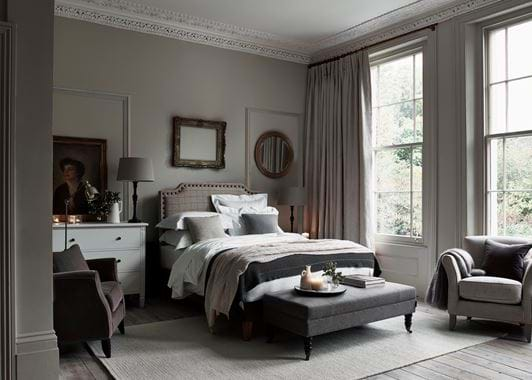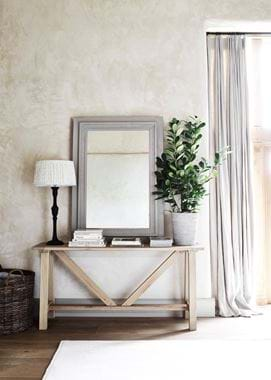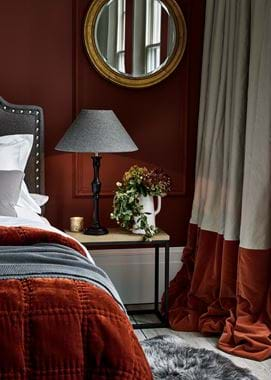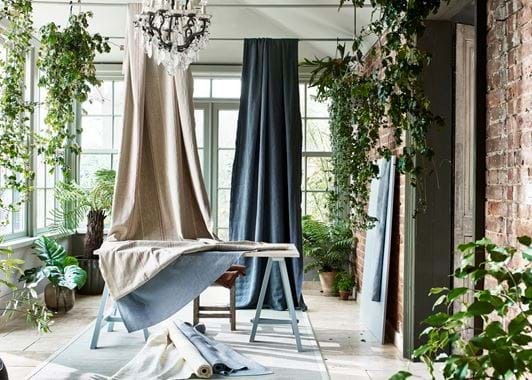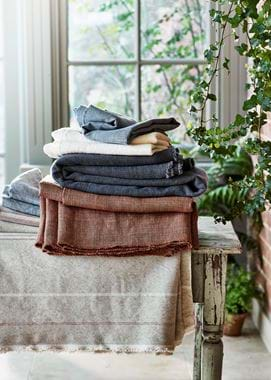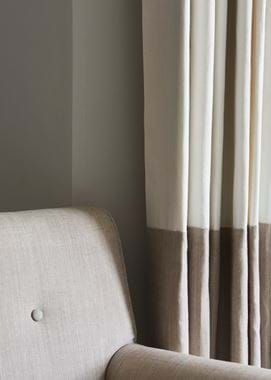Curtain call(ing) – choosing the right sort for your bedroom
Curtain call(ing) – choosing the right sort for your bedroom
nstantly comforting, visually and (literally) warming, decorative and, done well, utterly timeless, curtains are an underrated source of enrichment for almost every room under your roof. In the bedroom, they act as another blanket. Draw them shut at night and they’re akin to tucking yourself in and dimming the lights. Pull them open in the morning and they’re an extension of throwing back the covers and letting a new day unfold. But how to choose the right fabric, the right heading and the right length befitting to the boudoir? Here, our interior design manager, Simon (who introduced the handmade curtain collection at Neptune), shares his answers to your most-asked curtain questions.
Q. Should my curtains always be full-length? What about if I have a radiator below my window?
A: At Neptune, we certainly always advise on a to-the-floor finish for your curtains, because it’s infinitely more elegant than when they come to an abrupt halt halfway down. Even if your window isn’t full-length, your curtains can certainly cascade below the window frame.
In terms of the radiator conundrum, one is by no means a barrier to having longer curtains. Yes, your curtains will block the heat from circulating around the room when they’re drawn, but in our eyes, that’s a sacrifice worth making if curtains are what your heart longs for. Also, don’t underestimate how your curtains will aid in keeping the room warmer in their own right due to the volume of fabric. And, come nighttime when your bedroom curtains will be closed, you’ll be wrapped up tight in a duvet anyway, so a chill is unlikely to chase.
Alternatively, you could have a Roman blind over such a window with what we call ‘dress curtains’ either side. That way, you have the best of both worlds – a blind for privacy and to block the light, and curtains that serve for decorative purposes only.
Q. Can I use any sort of fabric on my curtains?
A: Not quite. Linens, velvets, wools and so on are all possible textiles to use on curtains, but you need to take into account the exact DNA of each fabric as some suit curtain-making more so than others.
Much like in upholstery, you need to consider the repeat and the joins in patterned fabrics because, for some, the reality of using that fabric on a larger scale can be much too fussy and fiddly, resulting in a finish that falls short of perfection.
Similarly, the combination of yarns used to create a fabric aren’t always ideal for turning into curtains. Our Archie linens, as an example, don’t translate as well to curtains as they do upholstery and so we excluded those from the curtain collection.
The good news is, in brief, the core categories of fabric all make for fabulous curtains (wool hangs beautifully, velvet undulates in a very romantic way, and linen can be at once breezy and refreshing as it can be wholesome and cosseting). It’s simply a case of working with a specialist to ensure you’re choosing from the most suitable sort of each textile.
Q. Is it best to avoid velvet curtains as they might not suit my bedroom in spring and summer?
A: Velvet curtains are a surefire way to bring drama to the bedroom. Sleep there night after night and still, swathes of cotton velvet tumbling downwards will continue to mesmerise.
Be that as it may, when it comes to velvet curtains, there is something distinctly more suiting to colder, autumnal months. But don't be deterred as there are two options at your disposal for helping them to fit with all four seasons.
The first is remembering that your curtains, strong in presence as they are, are just one aspect of your room’s decor. So allow them to be the bedroom’s deeper, heavier feature, while ensuring everything else from paint colour to bedding, cushions, throws and accessories are updated to reflect the current season’s mood.
The second is to have just one section of the curtain in velvet to dial down the drama. In our curtain-making service, you can choose to have velvet as the leading edge alone, or as the lower third of your curtain, giving you just a panel of its deep-pile texture. In this way, you allow velvet’s character into the room but in a more controlled way that helps it to feel relevant all year round.
Q. I like the light, floaty linen look in my bedroom. Should I not have fully-lined curtains?
A: Your choice of lining is entirely up to you. Fully-lined curtains are a thing of beauty, providing a high level of insulation in the room and blocking out much of the light. But not everybody is seeking blanket-like weightiness.
You may not need to lose both lining and interlining, however. Linings should be carefully matched – lighter ones for heavier fabrics, and denser ones for more delicate textiles – so that everything looks its best from the front, and draught-proofing is maximised. But all of this is a topic for discussion so that balance can be sought out.
The best advice is to talk to your Neptune home designer. Show the fabric that you love, the overall vision for the room, and the amount of light diffusion you would be happy with. They’ll then be able to advise what sort of lining will achieve this so that you have the quality of a lined curtain but with the right degree of movement.
As a bit of inside information, we’re adding two subtly-coloured sheers to our fabric library in our soon-to-arrive spring 2020 collection that are best unlined – a lovely option for achieving that ethereal drape look.
Q. What’s the most elegant choice of heading that will suit my bedroom for years to come?
A: The heading plays a very important role in defining your curtains’ personality. It’s a mistake to assume that because it takes up just a small section at the very top, the eye won’t travel there.
Being made-to-measure, your curtains are an investment piece for the property. Should you move home, you're unlikely to take them with you, but the hope should be that they remain as you left them to be enjoyed for many years to come. And the heading very much helps in achieving that expression of timelessness.
In our collection, we purposefully only offer three types of heading because these are the ones that we believe won’t ever fall out of favour. The most subtle is the cartridge heading, suiting homes that are either contemporary or classic, whereas the pleated headings are more traditional in style, so particularly consider these if your home is a period or country property.
For more advice on curtains, blinds and window treatment design, pop into your local Neptune store. Our home specialists will be able to share our collection of fabrics suitable for curtains and discuss the details of our made-to-measure, hand-crafted curtain service.

